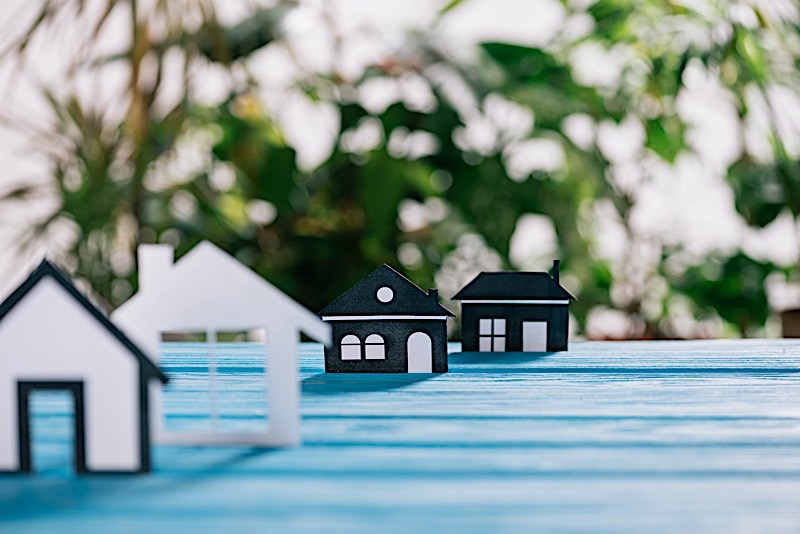For many people, buying a house is the largest purchase they will ever make. It can take anywhere from a few months to several years to save up a down payment, and most mortgages are financed for 15 to 30 years. Even seasoned real estate investors have to spend time securing funding before buying a property. This begs the question: why are houses so expensive?
The average price of a house has changed dramatically over the last few decades. This trend is a result of changing economic factors, rising construction costs, and many other elements. Below we will outline historical shifts in housing prices and what factors have contributed to these changes. Keep reading to learn more about why houses are so expensive and how this could impact your home buying experience.
History Of Housing Prices
The first U.S. housing census was in 1940 when the average price of a single-family home was around $30,600 (when adjusted for inflation). According to the HUD & Census Bureau, the average price of a single-family home was $446,300 as of January 2025. So, how did prices go from $30,600 to $446,300?
For the most part, the average cost of a home has experienced steady growth since 1940. However, there have been some spikes and falls caused by various economic factors. The most significant increase in home prices was recorded in the 1970s, with prices growing by 43 percent over the decade. This was followed by the slowest growth period over the 1980s when home prices increased by about 8 percent. There have also been short periods of decline; for example, during the Great Recession in the 2000s, home prices fell by almost 12 percent.
Unfortunately, average salaries and wages in the U.S. have not risen at the same rate as home prices. According to Pew Research Center, wages grow between two and three percent each year. This gap has left many Americans unable to purchase property, particularly in recent years. Although, there are many homeownership programs aimed at combating this reality.
It is also interesting to note how home prices have grown at different rates regionally. For example, the largest increase in the average price of a single-family home is in the Northeastern United States. According to Investopedia, the smallest increases have been seen in the South and Midwest regions. While housing prices fluctuate depending on the area, the U.S. has generally seen growth across the country.
[ Thinking about investing in real estate? Register to attend a FREE online real estate class and learn how to get started investing in real estate. ]

Why Is Housing So Expensive?
The historical price growth seen in the U.S. housing market is a result of several factors. Political, economic, and other societal changes have combined to result in consistent price increases. Below are the main factors when asking why are houses so expensive:
-
Higher Interest Rates
-
Increase In Local Zoning Regulations
-
Higher Construction Costs
-
Lower Builder Confidence
-
Changing Demographics
-
Increase In Land Prices
-
Government Subsidies
-
Lower Supply
-
Inflation
-
Wages
1. Higher Interest Rates
One of the less obvious reasons home prices have increased over time is the impact of higher interest rates—particularly in markets where housing supply remains limited. While higher rates typically reduce buyer demand by increasing the cost of borrowing, they also discourage current homeowners from selling, since many are locked into much lower mortgage rates. This creates a supply crunch, as fewer homes are listed for sale. With demand outpacing the available supply, home prices can continue to rise despite the higher cost of financing. In this way, elevated interest rates can indirectly contribute to long-term price growth, especially in tight or competitive housing markets.
2. Increase In Local Zoning Regulations
As you may already know, building and zoning regulations have come a long way since 1940. The changes in these laws have directly resulted in home price increases, particularly in urban areas. A few examples of zoning regulations are permit requirements, neighborhood restrictions, and population density laws. Together, these have pushed home prices to become more expensive — as they often decrease the potential supply of housing.
3. Higher Construction Costs
Not all construction materials are made in the U.S. and must often be imported from other countries. Political changes and trade agreements have caused the prices of these imports to change over time. When it comes to the housing market, this has contributed to an increase in construction costs. Many materials are more expensive than they once were as a result of tariffs.
4. Lower Builder Confidence
A more recent factor that contributes to the increase in housing prices is a decline in homebuilding. During the Great Recession, many home builders faced significant losses on new construction. Unfortunately, many construction companies and home builders are still wary after these losses, and prices reflect this.
5. Changing Demographics
Home prices have also risen as a result of the new generation of homebuyers: millennials. This group began buying property over the last several years, which resulted in an increased demand for houses. Most notably, millennial homebuyers are drawn to suburban or mixed-use areas. Cliff Auerswald, president of All Reverse Mortgage, suggests that “people are trying to find other sources for income after the pandemic, and the new interest in real estate investments has increased the prices of many homes. People are becoming smarter with their strategies of paying mortgages, but there are also many scammers inflating prices within the investment industry.
6. Increase In Land Prices
Over time, population increases have resulted in less available land throughout the country. There is no shortage, but land is generally more expensive to buy than it once was. The increase in land costs is directly related to the rise in average home prices.
7. Government Subsidies
As home prices have increased, the U.S. government has attempted to provide to ease the costs. While these homeownership programs have been extremely beneficial for some, they have also contributed to increased prices. The argument is that subsidies enable homebuyers to pay more for properties, thus pushing sellers to charge more.
8. Lower Supply
Steven Day Owner of SD Garage Doors, says that “despite the fact that various political and economic variables contribute to overpriced housing, the major effect of rising prices is that demand outnumbers supply. The housing market grew overcrowded with potential purchasers and an insufficient amount of houses to sell as a result of numerous banking institutions lending to people with terrible credit and allowing them to acquire property”.
9. Inflation
Inflation has been a hot topic as of late, with many economists carefully watching the consumer-price-index. As a result of increased prices throughout the economy, the Fed has increased interest rates multiple times this year. Mortgage lenders respond by raising their own interest rates — which ripples throughout the housing market. While these increases may slow in the months ahead, inflation always has a way of impacting the housing market.
10. Wages
As prices have increased throughout the economy, wages have not been able to keep up. This unfortunate reality has led to a sharp decrease in affordability in housing prices, both for potential buyers and renters. As wages struggle to keep up with inflation, this disparity is likely to remain a roadblock for many.
Why Are Houses So Expensive Right Now?
In 2025, home prices remain elevated across much of the U.S., largely due to a persistent imbalance between supply and demand. While many expected the housing market to cool off after the post-pandemic boom, prices have stayed high—not because demand has surged, but because there simply aren’t enough homes for sale. Builders are still catching up from years of under-construction, particularly in the entry-level market, and many homeowners are choosing not to sell, thanks to the so-called rate-lock effect. With nearly half of all mortgages locked in at rates below 3.5%, homeowners are reluctant to give up their low monthly payments for today’s rates, which remain well above 6%.
This limited supply has kept competition high, even as affordability challenges grow. First-time and middle-income buyers are especially squeezed, with many priced out of markets that once offered a path to homeownership. And while home prices aren’t rising at the breakneck pace seen during 2020–2022, they’re still climbing slowly, especially in areas where inventory is scarce and demand remains strong.
Despite high interest rates, experts stress that this doesn’t mean it’s a bad time to buy. Real estate is a long-term investment, and buying now—especially with the potential to refinance later—can still be a smart financial move. For many, finding the right property might mean adjusting expectations, whether that’s looking at condos, smaller homes, or considering fixer-uppers. But with steady price appreciation over time, building equity sooner rather than later can still pay off.
For a deeper dive into the current housing market dynamics, including expert insights on affordability, inventory, and interest rates, check out the article from Yahoo Finance.

How Do Rising Housing Prices Affect Investors?
Rising housing prices affect investors in two main ways: increased acquisition costs and increased profit potential. Investors are not immune to rising housing costs and will need to raise more funding to secure their deals. It is crucial to have funding sources to be able to act fast when a new deal presents itself. Additionally, investors must accurately factor in high purchase prices when analyzing the potential returns on a property.
In some cases, the increase in housing prices directly results in higher profit potential for real estate investors. This is because in many areas houses are appreciating faster than ever before. If you are lucky enough to break into a popular market, you could benefit greatly from increases in housing prices. Remember that this is not always the case, and you should always evaluate deals on a case-by-case basis (even if the market appears to be performing well overall).
Advice For Buyers And Sellers
In 2025, buyers and sellers are navigating a real estate market still adjusting from the disruptions of the COVID-19 pandemic. While interest rates remain high compared to the historic lows of the early 2020s, that shouldn’t be a reason to hold off entirely—real estate is a long-term investment, and today’s rates may look quite different in the years ahead. Many buyers, especially those who’ve spent years renting, are seeking stability, space, and ownership. The key is to stay focused on your personal financial situation and long-term goals, rather than trying to perfectly time the market.
Sellers, meanwhile, should approach the current climate with careful planning. While home values have appreciated significantly in recent years, entering the market as a seller means you’ll likely be re-entering it as a buyer. With inventory still tight in many areas, and borrowing costs higher, it’s important to have a clear strategy in place before listing your home. That said, real estate continues to be a strong long-term asset, and with proper planning, there will still be plenty of opportunity to benefit from market gains.
Will Housing Prices Go Down In 2025?
As we move through 2025, the housing market remains defined by two major forces: high interest rates and persistently low inventory. Over the past year, home prices continued to rise in many areas—not necessarily because demand surged, but because there simply aren’t enough homes available. With fewer listings on the market, even in the face of elevated borrowing costs, prices have held steady or even increased in many regions.
That said, we’re not seeing the same explosive price growth that defined the early pandemic years. Higher interest rates have cooled buyer activity somewhat, and while some markets are seeing modest slowdowns, a significant drop in home prices isn’t likely in the near future. Inventory challenges—driven by homeowners reluctant to sell and limited new construction—are keeping supply tight. Even as the market adjusts to post-COVID dynamics, the long-term forecast still points to gradual price growth, just at a more sustainable pace than before.
Most Expensive States To Buy A House
Certain real estate markets are growing faster than others, driving up prices and speeding up the typical listing time. In a recent article from Redfin, they outlined the most expensive states to buy a home. While California has historically been associated with an expensive, highly competitive real estate market there are several other states with competitive conditions. Here are some of the most expensive states to buy a house:
-
California: The Golden State is typically what comes to mind when thinking about expensive real estate. In 2025, the average home price is $785,000. While people may be leaving certain urban areas, the state remains a popular place to live.
-
Hawaii: Hawaii is a string of islands known for its tropical climate and beautiful landscape. The population is not particularly large, but limited real estate is competitive. According to Redfin, the average sales price in 2025 is roughly $779,000.
-
Massachusetts: Massachusetts offers a blend of historic charm, coastal beauty, and a strong job market, particularly in tech and education. However, living here doesn’t come cheap—home prices are among the highest in the U.S., especially in scenic coastal towns like Edgartown and West Tisbury. While Boston is pricey, some suburbs and smaller towns are even more expensive. The median sale price of a home is around $622,000.
-
Colorado: Colorado is one of many states that saw an influx of people as a result of COVID-19 and then continued to grow as the state’s tech sector and mountain towns draw in new residents. Again, the state offers beautiful landscapes and promising job growth. The average home value is right at $607,000 though it could increase in the coming months – almost double the value than a few years ago.
-
Washington: Another state of the Pacific Northwest, Washington has seen an influx of people as job opportunities grow in the area. Aside from job growth, many people are attracted to the area for the lush green landscape and outdoor activities. The median home value is right around $606,000 at the start of 2025, nearly $200,000 above the national average.
Summary
Homeownership is at the core of the American dream. For many, buying a house is a once-in-a-lifetime accomplishment, while others make their living buying and selling real estate. Either way, the steady increase in home prices has presented challenges for many individuals. Despite the government’s best efforts at subsidizing these costs, home prices have still risen significantly over the last few decades. When looking at the answer to “why are homes so expensive” remember that this problem results from several factors. Remember to plan accordingly if you are interested in owning real estate, and keep an eye out for all of the various financing methods available to you.
Ready to start taking advantage of the current opportunities in the real estate market?
Click the banner below to take a 90-minute online training class and get started learning how to invest in today’s real estate market!

